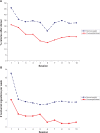Behavioral management of night eating disorders
- PMID: 23569400
- PMCID: PMC3616128
- DOI: 10.2147/PRBM.S31929
Behavioral management of night eating disorders
Abstract
Night eating syndrome (NES) is a form of disordered eating associated with evening hyperphagia (overeating at night) and nocturnal ingestions (waking at night to eat). As with other forms of disordered eating, cognitive and behavioral treatment modalities may be effective in reducing NES symptoms. This review presents evidence for a variety of behavioral treatment approaches, including behavioral therapy, phototherapy, behavioral weight loss treatment, and cognitive-behavioral therapy. A more detailed overview of cognitive-behavioral therapy for NES is provided. All of these studies have been case studies or included small samples, and all but one have been uncontrolled, but the outcomes of many of these approaches are promising. Larger randomized controlled trials are warranted to advance NES treatment literature. With the inclusion of NES in the fifth edition of the Diagnostic and Statistical Manual of Mental Disorders (DSM-5) as a "Feeding or Eating Disorder Not Elsewhere Classified," more sophisticated, empirically-supported, behaviorally-based treatment approaches are much needed.
Keywords: behavior therapy; behavioral weight loss; cognitive-behavioral treatment; night eating syndrome; phototherapy.
Figures

References
-
- Stunkard AJ, Grace WJ, Wolff HG. The night-eating syndrome: a pattern of food intake among certain obese patients. Am J Med. 1955;19(1):78–86. - PubMed
-
- Striegel-Moore RH, Franko DL, Garcia J. The validity and clinical utility of night eating syndrome. Int J Eat Disord. 2009;42(8):720–738. - PubMed
-
- Striegel-Moore RH, Franko DL, May A, Ach E, Thompson D, Hook JM. Should night eating syndrome be included in the DSM? Int J Eat Disord. 2006;39(7):544–549. - PubMed
-
- DSM-5 development [webpage on the Internet] Arlington, VA: American Psychiatric Association; 2012Available from: http://www.dsm5.org/ProposedRevision/Pages/proposedrevision.aspx?rid=26Accessed February 7, 2013
Grants and funding
LinkOut - more resources
Full Text Sources
Other Literature Sources
Research Materials

